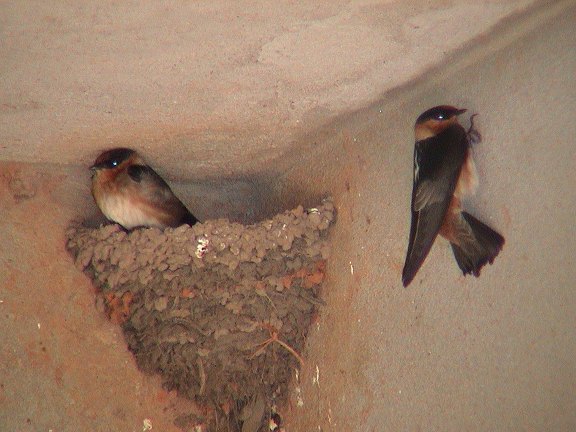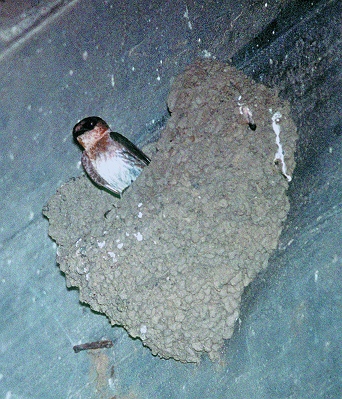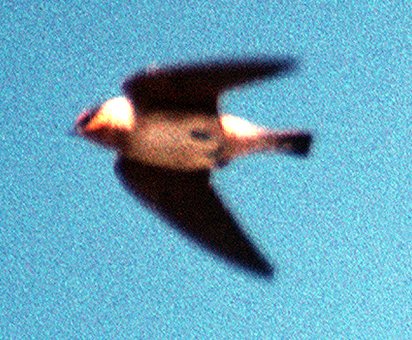|
Cave Swallow Petrochelidon fulva Golondrina de Cuevas
|
 |
|
Photo: G. Beaton
|
|
Cave Swallow Petrochelidon fulva Golondrina de Cuevas
|
 |
|
Photo: G. Beaton
|
|
IDENTIFICATION: A square-tailed swallow, blue-gray above with a chestnut-colored rump and forehead. Other common swallows in Puerto Rico have forked tails. Length: 12-14 cm.; weight: 19 g. VOICE: A high-pitched chatter, which it often gives in flight. Audio (M. Oberle). HABITAT: Farms, beaches, mangroves, open country, marshes, and towns. HABITS: The Cave Swallow, singly or in loose flocks of several dozen birds, can be seen throughout the day feeding on airborne insects. Alexander Wetmore found 22 species of insects in the stomachs of Cave Swallows in Puerto Rico including flies (Diptera), beetles (Coleoptera), grasshoppers (Orthoptera), bugs (Hemiptera), and wasps (Hymenoptera). The Cave Swallow nests in colonies in caves, sea cliffs, and sinkholes, under bridges and on ledges of buildings. It has even been reported nesting on cruise ships in the Caribbean. It builds a globular nest by scooping up mud from puddles or stream banks, and dabbing the mud on a ledge, one bill-full at a time. The nest may be used from one year to the next. The female lays 3-4 white eggs with brown spots. She does most of the incubation of the eggs, but the male helps out later in feeding the chicks. STATUS AND CONSERVATION: A common, permanent resident of Puerto Rico. It has probably benefited from the expansion of agriculture in the last two centuries, as well as the additional nest sites that human construction provides. RANGE: From southern Texas and New Mexico south to Peru. In the Caribbean it occurs in the Greater Antilles. TAXONOMY: PASSERIFORMES; HIRUNDINIDAE; Hirundininae. Formerly in the genus Hirundo. The newly-described, endemic Puerto Rican subspecies (Petrochelidon fulva puertoricensis) has a darker, chestnut-colored breast, rump and sides when compared to other subspecies elsewhere. Taxonomists have proposed dividing the Cave Swallow into separate species: the Fulvous Swallow (Petrochelidon fulva) breeding in the Greater Antilles, southern Mexico and southern Florida, and the larger and lighter-colored Cave Swallow (Petrochelidon pelodoma) breeding in the southwestern USA and northern Mexico. |
|
 |
|
|
Photo: C. Ruiz*
|
 |
|
Photo: R. Rodríguez Mojica
|
 |
|
Photo: M. Oberle
|
 |
|
|
Photo: G. Beaton
|
 |
|
|
Petrochelidon fulva pelodoma (Texas)
- Photo: G. Beaton
|
|
References Bent, A.C. 1942. Life histories of North American flycatchers, larks, swallows, and their allies. Smithsonian Instit. U.S. National Museum Bull. 179. (Reprinted by Dover Press, NY, 1963). Garrido, O. H., A.T. Peterson, and O. Komar. 1999. Geographic variation and taxonomy of the Cave Swallow (Petrochelidon fulva) complex, with the description of a new subspecies from Puerto Rico. Bull. Brit. Orn. Club 119:80-91. Raffaele, H.A. 1989. A guide to the birds of Puerto Rico and the Virgin Islands. Princeton. Raffaele, H.A. 1989. Una guía a las aves de Puerto Rico y las Islas Vírgenes. Publishing Resources, Inc., Santurce, PR. Raffaele, H.A., J.W. Wiley, O.H. Garrido, A.R. Keith, and J.I. Raffaele. 1998. Guide to the birds of the West Indies. Princeton. Turner, A. and C. Rose. 1989. Swallows & martins: an identification guide and handbook. Houghton, Mifflin, Boston. West, S. 1995. Cave Swallow (Hirundo fulva). No. 141 in The birds of North America (A. Poole and F. Gill, eds.). Acad. Nat. Sci., Philadelphia, PA, and Am. Ornithol. Union, Washington, D.C. Next related species in taxonomic order Previous related species in the taxonomic order |